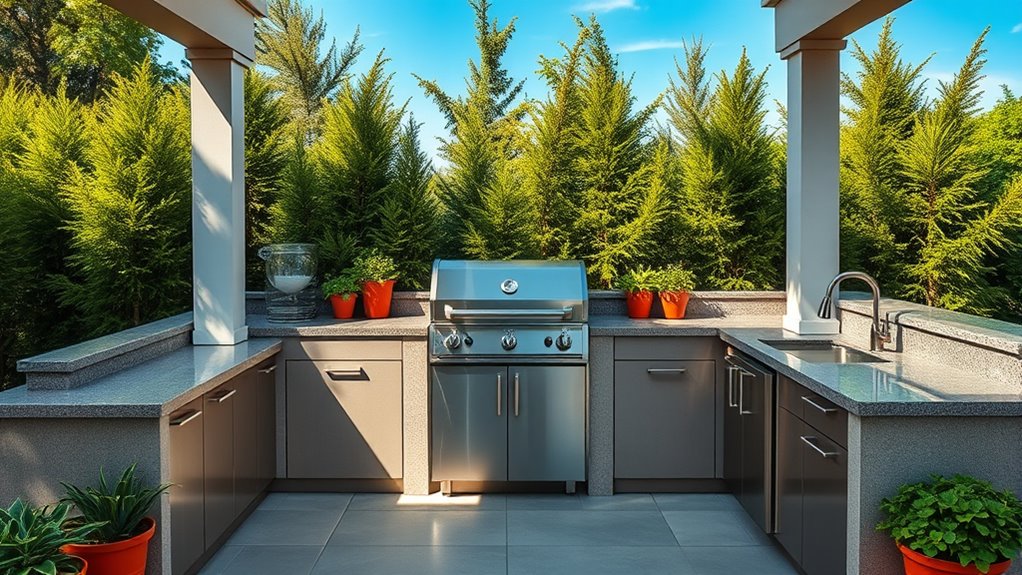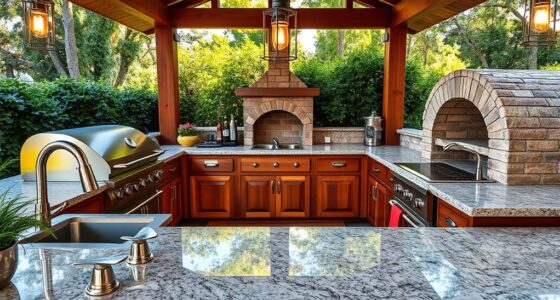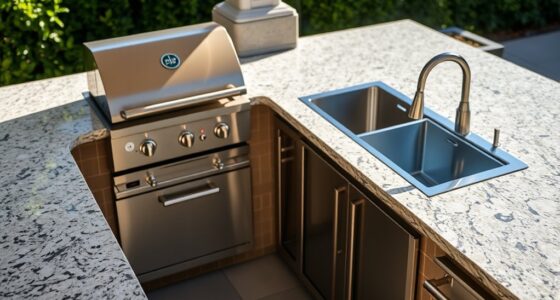To optimize your outdoor kitchen, focus on the classic work triangle by placing your grill centrally for easy access and ensuring clear pathways between the prep area, cooking zone, and cleanup spot. Keep work areas free of clutter, store items within reach but not crowding the space, and maintain safe distances from flammable materials. Incorporate flexible features and good lighting to suit various cooking styles and guarantee accessibility. Continue exploring these tips to create a seamless outdoor culinary experience.
Key Takeaways
- Place the grill, sink, and refrigerator in a triangle layout to minimize movement and improve efficiency.
- Maintain optimal distances between these elements to ensure safety and ease of access.
- Keep pathways clear around the work triangle to prevent obstructions and enhance workflow.
- Position the work triangle centrally for balanced access from prep, cooking, and cleanup zones.
- Adjust the triangle based on space, cooking style, and user needs for maximum functionality.
Prioritize the Classic Triangle for Efficiency
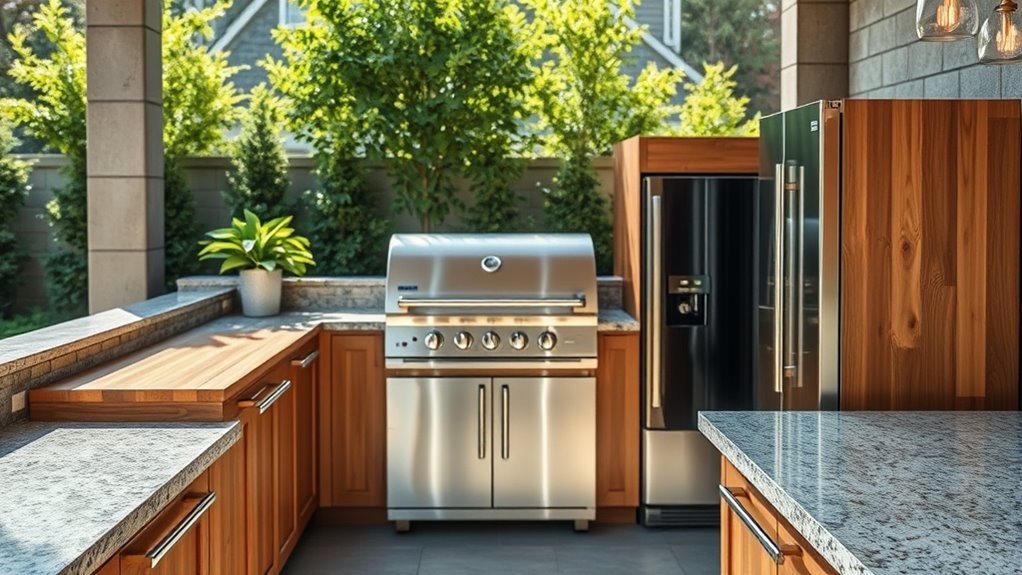
To maximize efficiency in your outdoor kitchen, it’s essential to prioritize the classic work triangle. You want your grill placement to be central, allowing easy access from both the prep and serving areas. Proper countertop design supports this flow by providing enough space for prep work without causing congestion. Keep the main work zones—cooking, prep, and cleanup—in close proximity but avoid cluttering them. When you position your grill thoughtfully, you’ll streamline your cooking process and reduce unnecessary movement. A well-designed countertop complements this setup, giving you ample workspace while maintaining the triangle’s balance. Additionally, incorporating natural materials like wood or stone in your outdoor kitchen can enhance durability and aesthetic appeal, making your space more inviting. This focus on the classic work triangle guarantees your outdoor kitchen functions smoothly, making outdoor cooking more enjoyable and efficient.
Keep the Work Areas Clear of Obstructions

Keeping your work areas free of obstructions is vital for maintaining an efficient outdoor kitchen. Obstruction clearance ensures you have a clear path to move smoothly between cooking, prep, and cleanup zones, reducing accidents and delays. Pathway safety is fundamental—you don’t want clutter blocking your movement or creating tripping hazards. Regularly check for and remove tools, furniture, or debris that may interfere with your workflow. Use the table below to visualize common obstructions and their impact:
| Obstruction | Effect on Workflow |
|---|---|
| Unused equipment | Clutters space, causes delays |
| Overgrown plants | Limits access, creates tripping hazards |
| Excess furniture | Blocks pathways, reduces safety |
Additionally, considering the water park amenities nearby can encourage proper storage and organization of outdoor kitchen items, preventing clutter from spilling over into recreational areas.
Maintain Optimal Distance Between Key Elements

Ensuring the right spacing between your outdoor kitchen elements is crucial for efficient workflow and safety. Proper grill placement keeps it accessible yet safely distanced from flammable materials, reducing fire risks. Storage zones should be close enough for convenience but far enough to prevent clutter and overcrowding. Keep counters and prep areas within a comfortable reach of the grill to streamline cooking. Avoid placing the grill too close to sinks or seating areas to prevent accidents and ensure airflow. Space out appliances and storage cabinets to prevent congestion and allow easy movement. Maintaining ideal distances helps minimize cross-traffic and makes your outdoor kitchen safer and more functional. Focus on balancing proximity for convenience with sufficient separation for safety and efficiency. Additionally, considering the home essentials can help optimize your outdoor kitchen layout for durability and ease of maintenance.
Incorporate Flexibility for Different Cooking Styles
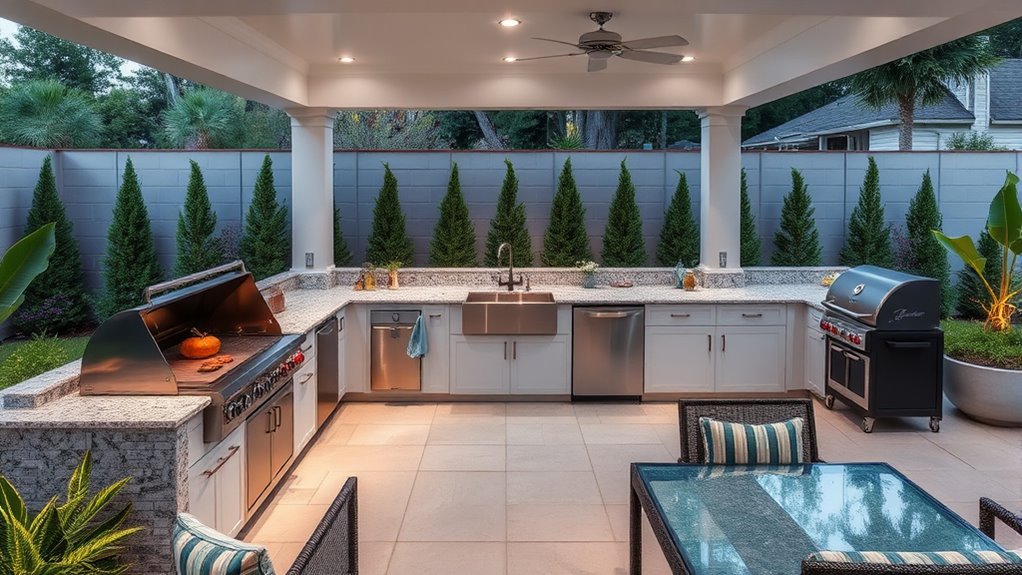
Design your outdoor kitchen with flexibility in mind to accommodate a variety of cooking styles. A versatile design allows you to switch seamlessly between grilling, prep work, and outdoor entertaining. Incorporate adaptable cooking options like a combination grill and smoker, or add a side burner for sauces and sides. Include movable or adjustable features, such as removable countertops or flexible storage, to adapt to different needs. This approach ensures your outdoor space can handle everything from casual barbecues to elaborate gatherings. By prioritizing versatility, you create an efficient work triangle that supports various cooking methods without sacrificing flow or convenience. Additionally, designing for adaptability helps future-proof your outdoor kitchen, allowing it to evolve with your culinary preferences and lifestyle. A flexible design not only enhances functionality but also makes your outdoor kitchen more enjoyable and adaptable to your evolving culinary preferences.
Plan for Adequate Lighting and Accessibility

Proper lighting and easy accessibility are essential components of an effective outdoor kitchen. You need to guarantee your space is well-lit with appropriate garden lighting that illuminates work areas, pathways, and seating zones for safety and convenience. Incorporate layered lighting options like task lights, ambient lighting, and accent lighting to create a functional and inviting environment. Accessibility is equally important; make sure your outdoor kitchen complies with ADA standards by designing paths and countertops at appropriate heights and providing ramps where needed. Clear pathways free of obstructions allow everyone to navigate comfortably. Planning for adequate lighting and accessibility not only enhances safety but also ensures your outdoor kitchen is welcoming and usable for all guests, regardless of mobility or time of day. Additionally, understanding the risk management of your outdoor space can help you make informed decisions about lighting and layout to reduce hazards and improve safety for all users.
Frequently Asked Questions
How Do I Customize the Work Triangle for My Specific Outdoor Space?
To customize the work triangle for your outdoor space, start with personalization tips that suit your cooking style and preferences. Measure your area carefully, then arrange appliances to minimize travel distance between the grill, prep zone, and sink. Focus on space optimization by leaving enough room for movement and storage. Adjust the triangle’s shape to fit your layout, ensuring it’s functional and comfortable, making outdoor cooking more enjoyable and efficient.
What Materials Best Withstand Outdoor Conditions for Kitchen Elements?
You should choose weather-resistant countertops like granite, quartz, or stainless steel, which stand up to outdoor elements. For cabinetry, opt for durable materials such as treated cedar, composite, or powder-coated metals that resist moisture and sun damage. These materials guarantee your outdoor kitchen remains functional and attractive over time, regardless of weather conditions. Regular maintenance helps extend their lifespan and keeps your space looking great.
How Can I Integrate Storage Solutions Within the Work Triangle?
Imagine you install a built-in cabinet near your grill and sink to maximize storage organization and space optimization. This seamless integration keeps essential tools within reach, reducing clutter and improving flow within your outdoor kitchen work triangle. You can also add pull-out shelves or drawer systems to make everything easily accessible. By thoughtfully designing storage solutions into your layout, you enhance functionality without sacrificing style or convenience.
What Are Common Mistakes to Avoid When Designing an Outdoor Kitchen?
When designing your outdoor kitchen, avoid poor landscape integration that clashes with your surroundings and neglecting lighting considerations, which can make cooking difficult at night. Don’t place appliances too far apart, disrupting the work triangle, or overlook weather-resistant materials that withstand outdoor conditions. Keep these mistakes in mind to create a functional, cohesive space that’s welcoming day or night, seamlessly blending with your landscape.
How Do I Ensure Safety While Maintaining an Efficient Work Triangle?
Imagine you’re a knight in a modern castle, guarding against fire hazards. To guarantee safety while maintaining an efficient work triangle, follow strict safety protocols like proper ventilation, keeping flammable materials away from heat sources, and installing fire extinguishers nearby. Avoid clutter and ensure clear pathways. Regularly inspect equipment. These steps help prevent accidents, allowing you to cook confidently while keeping your outdoor kitchen safe and functional.
Conclusion
By following these five golden rules, your outdoor kitchen becomes a well-choreographed dance floor, where every move flows seamlessly. Think of the work triangle as your culinary highway—smooth, direct, and obstacle-free. With clear paths and smart planning, you’ll turn your outdoor space into an inviting oasis where cooking feels effortless and enjoyable. So, embrace these principles, and let your outdoor kitchen become the stage for delicious memories waiting to unfold.
